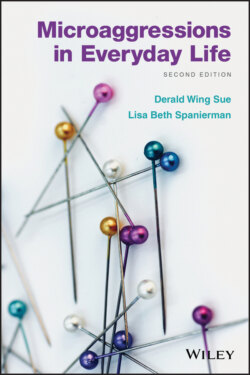Читать книгу Microaggressions in Everyday Life - Derald Wing Sue - Страница 11
What Are Microaggressions?
ОглавлениеThe term “microaggressions” was coined by African American psychiatrist and Harvard University professor Chester Middlebrook Pierce in his work with Black Americans. He defined microaggressions as “subtle, stunning, often automatic, and nonverbal exchanges which are ‘put‐downs’” (Pierce, Carew, Pierce‐Gonzalez, & Willis, 1978, p. 66). They also have been described as “subtle insults (verbal, nonverbal, and/or visual) directed toward people of color, often automatically or unconsciously” (Solórzano, Ceja, & Yosso, 2000, p. 60).
While early theorizing focused solely on racial microaggressions, microaggressions can be expressed toward any marginalized group in our society. They can be linked to racism, sexism, genderism, heterosexism, classism, ableism, and other forms of oppression (Nadal, Whitman, Davis, Erazo, & Davidoff, 2016; D. W. Sue & Capodilupo, 2008). In this book we concentrate on specific forms of microaggressions that have garnered research support (e.g., racial, gender, and sexual‐orientation microaggressions) and also feature a wave of research that emerged since publication of this book's first edition, such as trans and genderqueer microaggressions (Nadal, Whitman, et al., 2016); religious microaggressions (Dupper, Forrest‐Bank, & Lowery‐Carusillo, 2014; Husain & Howard, 2017); classist microaggressions (Gray, Johnson, Kish‐Gephardt, & Tilton, 2018; Smith, Mao, & Deshpande, 2016); and intersectional microaggressions (Lewis & Neville, 2015; Nadal et al., 2015). We introduce research from national contexts beyond the United States, including Australia, Canada, Mexico, and the United Kingdom. And, importantly, we introduce two new concepts: macroaggressions as distinct from microaggressions, and microinterventions to highlight resistance and resilience to microaggressions and macroaggressions (D. W. Sue, Alsaidi, et al., 2019).
It has been helpful for students learning about microaggressions to consider the components of the term to define it. First, in this case, “micro” does not refer to being small or innocuous but rather underscores the interpersonal, microlevel context of the act. Microaggressions denote some sort of interpersonal interaction involving a perpetrator and a target (marginalized group member). Second, we must keep in mind the term “aggression.” Most often, social psychologists have defined aggression as verbal or nonverbal behavior intended to harm. At the same time, some forms of aggression (indirect, social, and relational) may exclude others or harm their reputations, with or without intention to do so (Archer & Coyne, 2005). These latter forms of aggression shape our understanding of microaggressions that take shape as insults, invalidations, or assaults.
Thus, microaggressions are verbal and nonverbal interpersonal exchanges in which a perpetrator causes harm to a target, whether intended or unintended. These brief and commonplace indignities communicate hostile, derogatory, and/or negative slights to the target (D. W. Sue, Capodilupo, et al., 2007). Importantly, microaggressions theory values the target's perception in identifying harm, as perpetrators often are unaware that they have engaged in an exchange that demeans the target. In Chapter 3, we elaborate on this point by describing four psychological dilemmas and dynamics of microaggressions.
To illustrate the concept of a subtle microaggression not intended to cause harm, the second author (Lisa Spanierman) recounts an experience boarding a flight on a major U.S. airline. An African American NFL Hall of Famer handed his first‐class boarding pass to the gate agent. Without hesitation, the agent scoffed, “We are boarding first class now.” It is unlikely that the gate agent meant to cause harm to this Hall of Fame running back. Rather, she was working from an assumption that African Americans do not belong in the first‐class cabin. During the flight, Professor Spanierman told the football pro that she studies racial microaggressions; he replied that he encounters this experience all too often. Ironically, he was recognizable to many of the passengers who were shaking his hand and taking selfies with him as they boarded the aircraft. Professor Spanierman filed a complaint with the airline and received a generic reply from their customer service department (“Thank you for sharing your concerns … we should have been more responsive”). Notably, in 2017, the National Association for the Advancement of Colored People (NAACP) issued a warning to African American passengers about flying American Airlines due to several incidents that suggested a corporate culture of racial insensitivity and bias. Later we discuss the interplay between individual incidents of insensitivity and broader institutional and cultural forms of racism. It is the latter (systemic racism) that allows the former (racial microaggressions) to thrive.
Any one microaggression alone may be minimally impactful, but when they occur continuously throughout a life span, their cumulative nature can have major detrimental consequences (Holmes & Holmes, 1970; Holmes & Rahe, 1967; Jones, Peddie, Gilrane, King, & Gray, 2016; Meyer, 1995, 2003; Utsey, Giesbrecht, Hook, & Stanard, 2008; Utsey & Ponterotto, 1996). Many White individuals, for example, fail to realize that people of color are, from the moment of birth, subjected to multiple racial microaggressions from the media, peers, neighbors, friends, teachers, and even in the educational process and/or curriculum itself. These insults, invalidations, and indignities are so pervasive that they often are unrecognized. In this chapter, we contextualize racial and gender microaggressions in larger systems of oppression and apply the concepts to the two examples provided earlier in the chapter.
